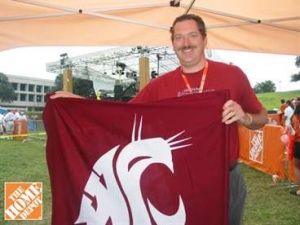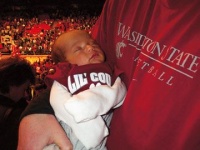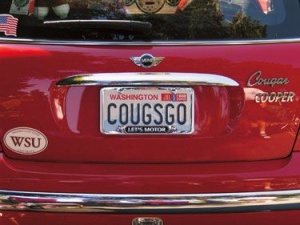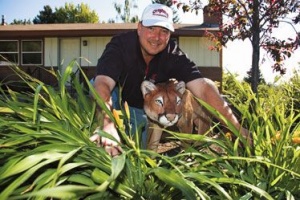Personal tools
Help
Tools
Class Notes
- Do you have news for fellow WSU alumni and other readers of Washington State Magazine? Send us your class note.
Our Story
written by alumni, faculty and friends.
NOTE: THIS IS A LEGACY SITE AND IS NOT REGULARLY MAINTAINED
Views
Difference between revisions of "How Coug Are You?"
From Our Story
m (Protected "How Coug Are You?": wsm article [edit=author:move=author]) |
m |
||
| Line 1: | Line 1: | ||
| − | By Hannalore Sudermann | + | By Hannalore Sudermann |
| − | |||
| − | |||
| + | From ''Washington State Magazine'', Fall 2005 | ||
| + | <br> | ||
[[Image:Poundsflag.jpeg|thumb|right|300px|Tom starts the first of many visits by this flag, to the ESPN CollegeGameday show.]]It was nearing midnight one Wednesday in October 2003, and Tom Pounds ('81 Engr.) was up with his mother at his home in Albuquerque, New Mexico, piecing together a giant flag with his university logo. At dawn the next morning, he began a two-day drive to the University of Texas campus in Austin to stand in a mass of unruly football fans and wave the Washington State University banner on a pole for a few minutes on TV. | [[Image:Poundsflag.jpeg|thumb|right|300px|Tom starts the first of many visits by this flag, to the ESPN CollegeGameday show.]]It was nearing midnight one Wednesday in October 2003, and Tom Pounds ('81 Engr.) was up with his mother at his home in Albuquerque, New Mexico, piecing together a giant flag with his university logo. At dawn the next morning, he began a two-day drive to the University of Texas campus in Austin to stand in a mass of unruly football fans and wave the Washington State University banner on a pole for a few minutes on TV. | ||
| Line 19: | Line 19: | ||
Cougar fans around the country noticed the WSU flag and wondered why they were seeing it on a broadcast from Texas on a day the Cougars were playing in Pullman. | Cougar fans around the country noticed the WSU flag and wondered why they were seeing it on a broadcast from Texas on a day the Cougars were playing in Pullman. | ||
| − | Brent Schwartz, a student at Northwestern College in St. Paul, Minnesota, was taken with the idea. Two weeks after Pounds's display, the younger Cougar fan drove 250 miles to wave the flag during the broadcast for a game in Madison, Wisconsin. That weekend, the Cougars were playing in Palo Alto. | + | Brent Schwartz, a student at Northwestern College in St. Paul, Minnesota, was taken with the idea. Two weeks after Pounds's display, the younger Cougar fan drove 250 miles to wave the flag during the broadcast for a game in Madison, Wisconsin. That weekend, the Cougars were playing in Palo Alto. |
Then John Bley, whose father Johnny was captain of the Washington State College football team in 1935, volunteered his daughter to take that same flag and wave it during the next broadcast in Bowling Green, Ohio. The Cougs were playing Oregon State in Pullman. | Then John Bley, whose father Johnny was captain of the Washington State College football team in 1935, volunteered his daughter to take that same flag and wave it during the next broadcast in Bowling Green, Ohio. The Cougs were playing Oregon State in Pullman. | ||
| Line 53: | Line 53: | ||
WAZZU style has no designer labels, but always some identifying WSU element, whether it's the color or the logo, and there's usually a flavor of defiance in the outfit and in the way the students carry themselves. "I'm thinking about the sweatshirts that say, "Damn right I'm a Coug," says Arthur. | WAZZU style has no designer labels, but always some identifying WSU element, whether it's the color or the logo, and there's usually a flavor of defiance in the outfit and in the way the students carry themselves. "I'm thinking about the sweatshirts that say, "Damn right I'm a Coug," says Arthur. | ||
| − | The sociologist has several theories as to how and why this strong attachment to the school is formed. One is Pullman's isolation, nearly 100 miles from the nearest freeway and more than an hour from a major urban center. | + | The sociologist has several theories as to how and why this strong attachment to the school is formed. One is Pullman's isolation, nearly 100 miles from the nearest freeway and more than an hour from a major urban center. |
Another is that WSU has historically been seen as a safe haven in a world of colleges and universities that reject more students than they accept. Arthur points to Washington's other big university, which is sometimes seen as aloof and elitist. Yet there has always been a place for students at WSU, she says. | Another is that WSU has historically been seen as a safe haven in a world of colleges and universities that reject more students than they accept. Arthur points to Washington's other big university, which is sometimes seen as aloof and elitist. Yet there has always been a place for students at WSU, she says. | ||
| Line 85: | Line 85: | ||
"He must have been new," says Sorensen, explaining that the tan-painted cougar has been in place for about a year, ever since he and his wife Shona bid on it during a local auction. "It was our anniversary present to each other," he says. | "He must have been new," says Sorensen, explaining that the tan-painted cougar has been in place for about a year, ever since he and his wife Shona bid on it during a local auction. "It was our anniversary present to each other," he says. | ||
| − | Sorensen was practically raised on campus. He came with his family to Pullman at the age of five when his father joined the faculty at WSU. The school has always been part of his sense of self, he says. "Once you're in the Cougar family, you're always in the Cougar family."<br> | + | Sorensen was practically raised on campus. He came with his family to Pullman at the age of five when his father joined the faculty at WSU. The school has always been part of his sense of self, he says. "Once you're in the Cougar family, you're always in the Cougar family."<br> |
| + | |||
| + | |||
| + | |||
| + | [[category:Cougar Pride]] | ||
Latest revision as of 16:55, April 6, 2009
By Hannalore Sudermann
From Washington State Magazine, Fall 2005
Each fall football weekend, ESPN sends a crew to the biggest game to present a live televised show prior to kick-off. On this weekend, Pounds had a mission.
"I don't know why I did it," says the first Cougar to wave a WSU flag on camera for an ESPN Gameday broadcast miles from where a WSU game was being played. "School spirit?"
By driving 800 miles and displaying his school logo in the midst of a screaming, waving crowd and on television, Pounds started a national movement. Nobody asked him to. No one paid him. And close to no one knew about it.
"Here I was, 45 in the midst of a bunch of 20-something kids," says the electrical engineer. "I got funny looks, and people swore at me."
Pounds didn't care that WSU had nothing to do with that Saturday game between Texas and Kansas State. "It was just something fun to do," he says. "I'm always up for something unique."
Cougar fans around the country noticed the WSU flag and wondered why they were seeing it on a broadcast from Texas on a day the Cougars were playing in Pullman.
Brent Schwartz, a student at Northwestern College in St. Paul, Minnesota, was taken with the idea. Two weeks after Pounds's display, the younger Cougar fan drove 250 miles to wave the flag during the broadcast for a game in Madison, Wisconsin. That weekend, the Cougars were playing in Palo Alto.
Then John Bley, whose father Johnny was captain of the Washington State College football team in 1935, volunteered his daughter to take that same flag and wave it during the next broadcast in Bowling Green, Ohio. The Cougs were playing Oregon State in Pullman.
"My dad had died a year before," says Bley, of Olympia. "I called my daughter up and said, 'This is a goofy idea, but college kids like to do goofy things.'"
From there it snowballed, as the flag that Pounds made was Fed-Ex-ed around the country for Gameday events. The banner didn't make it to every single broadcast in 2003, but by 2004, a cadre of volunteers was eager to drive hundreds of miles at their own expense to wave the flag in the background of every broadcast. It was all voluntary and all informal—a thankless duty, since the flag-wavers were never visible on camera. "When you consider the show is an hour and a half, with commercials, close-ups, and taped segments, the actual live time on the air with a crowd shot is actually only five minutes," says Pounds. "It's only then that you hoist the flag and you wave it like crazy."
Why did they do it? "You're trying to explain the unexplainable," says Bley. "There's just something that seems extremely unique about the experience at Washington State and Cougar football. Maybe it has something to do with the location [of the school], or a team that continues to confound. The fans get attracted to that, and they do extraordinary things."
There's a special connection people feel for this university, a connection that doesn't have anything to do with whether the football team is winning or losing, or even playing. It's a connection that makes them declare their love for WSU in ways both odd and public. They drive hundreds of miles to get a flag on TV. They paint a new car in Cougar colors. They plant several hundred pounds of cougar-shaped concrete in their yard. They cover an airplane in crimson and grey to proclaim WSU from the sky.
"I'm almost embarrassed," says veterinarian and pilot Kim Nicholas, laughing. "It's not like I'm a crackpot."
Nicholas recently completed his kit RV-9, a two-seater airplane, which he painted white with crimson striping. The interior is Cougar gray with crimson highlighting. "And I'm looking for stickers with the cougar footprint," to put on his wheel pants.
Nicholas came to WSU in 1975, earned his first bachelor's degree in 1979, then another, followed by a master's degree and finally a doctorate in veterinary medicine in 1984.
Now a veterinarian with a busy practice in Renton, a family, and plenty of other interests, he can't seem to break free of his Cougar ties.
"I spent nine years there," he says. "I think my connection with the school has to do a little bit with brainwashing. It's like Stockholm syndrome—you know, where you fall in love with your captor."
Linda Arthur, a sociologist and professor in the Department of Apparel, Merchandising, Design, and Textiles (AMDT), says this Cougar attachment starts early, sometimes before students hit WSU as undergraduates. Trained to look at how people present and identify themselves with material goods, Arthur is fascinated with the way students are identifying with the school.Arthur, who studies the social, cultural, and psychological aspects of dress and has done research at two other universities before coming to WSU, says the situation here is unique. "I've never been in such a place where the connection to the school is so manifest," she says. Businesses around town identify themselves with Cougar logos, Pullman residents don't go out without their WSU gear on, and people build special WSU-themed rooms in their houses.
But these displays aren't limited to Pullman, says Arthur. "What is it about this institution that keeps people connected throughout their lives?" she wonders.
With the help of her AMDT students, she set out to capture the components of student culture and the connections in their early stages. "We're looking at how Cougs show their Cougness," she says. "We're calling it 'WAZZU style.'"
First, they broke the students down into the four typical sub-cultures—collegiate, non-conformist, academic, and vocational/professional students. Then Arthur and colleague Mark Konty started to look at the ideocultures, or sub-subcultures. Through surveys of 1,200 undergraduates and alumni, they found that 65 percent of the student body fits the collegiate subculture, which includes members of the Greek system and athletes. It also includes a large percentage of students who follow WAZZU style, which Arthur describes as a no-fuss, easy-going approach to clothes and attitude.
WAZZU style has no designer labels, but always some identifying WSU element, whether it's the color or the logo, and there's usually a flavor of defiance in the outfit and in the way the students carry themselves. "I'm thinking about the sweatshirts that say, "Damn right I'm a Coug," says Arthur.
The sociologist has several theories as to how and why this strong attachment to the school is formed. One is Pullman's isolation, nearly 100 miles from the nearest freeway and more than an hour from a major urban center.
Another is that WSU has historically been seen as a safe haven in a world of colleges and universities that reject more students than they accept. Arthur points to Washington's other big university, which is sometimes seen as aloof and elitist. Yet there has always been a place for students at WSU, she says.
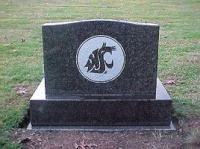
For some, the Cougar family is as important as their own. For others it is one and the same.
When Bruce Fritch ('76 Ag.) of Snohomish passed away in 2003, his family decided to memorialize his love for his alma mater by putting the Cougar logo on the back of his headstone.
Fritch had made great friendships at WSU and found Pullman to be a home away from home, says his family. His fondness for the school lasted long past graduation.
"It just made sense," says his brother Randy Fritch ('79 Ag. Eng.). "All the kids have graduated from WSU, and it's a pretty big part of our lives."
For good reason, universities try to create environments where students are surrounded by a cohort of like-minded classmates, providing a sense of safety and attachment, says Arthur. "If there's a cohort surrounding a student, the student is going to last in school longer. I think WSU figured that out a long time ago. The interpersonal relationships and the bonding and the emotional side of being connected to the school are things this university has done well for a long time."
Once the colors were set, the rally stripe along the body with the letters "WSU" and the Cougar logo on the gas tank lid came easily. Barb now happily drives it to the grocery store and expertly fields questions from the curious. Last summer the couple polished it up for a British car show in Bellevue.
Wayne has a dream of one day bringing the Cougar Cooper to a football weekend in Pullman. "I'm hoping that one game we can put Butch through the sunroof and drive him onto the field," he says.
When it comes to cars, most people make their WSU statement in a subtler way: with their license plates. Last year, 11,246 people either purchased or renewed WSU plates. (UW alums only bought 4,581.)
Maybe you have one of those plates, and maybe there's a stack of WSU sweatshirts in your closet. Or you might buy your granddaughter a crimson cheerleader uniform and a Barbie to match. Maybe you have a Cougar welcome mat and a Cougar flag in your yard. You might even have a Cougar room in your basement. But even if you have all of these things, you're not really trying hard enough.
It looks so real, that a Pullman police officer reported it and called for backup, says Sorensen. Another officer recognized it as the Sorensen's 300-pound lawn ornament and called off the investigation.
"He must have been new," says Sorensen, explaining that the tan-painted cougar has been in place for about a year, ever since he and his wife Shona bid on it during a local auction. "It was our anniversary present to each other," he says.
Sorensen was practically raised on campus. He came with his family to Pullman at the age of five when his father joined the faculty at WSU. The school has always been part of his sense of self, he says. "Once you're in the Cougar family, you're always in the Cougar family."
Our Story site map
Our Story main page | Our Story categories | Help Desk
Contact | Give | Advertise
Washington State Magazine | Washington State University | Class Notes
Our Story is coordinated by
In partnership with
Our Story and Washington State Magazine are publications of Washington State University. All rights reserved.
P.O. Box 641227, Washington State University, Pullman, WA 99164-1227 USA | wsm@wsu.edu, 509-335-2388
Accessibility | Copyright | Policies
